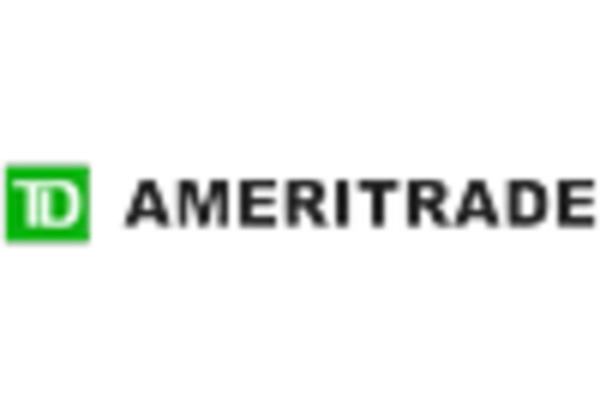Enhanced Security Measures
Security remains a paramount concern within the E-Brokerage Market, prompting firms to adopt enhanced security measures to protect user data and transactions. As cyber threats become more sophisticated, e-brokerage platforms are investing in advanced encryption technologies and multi-factor authentication systems. Recent findings indicate that over 70% of investors prioritize security when selecting an e-brokerage service. This heightened focus on security not only builds trust among users but also positions firms competitively within the E-Brokerage Market. By ensuring robust security protocols, e-brokerage platforms can mitigate risks and foster a safer trading environment, which is essential for attracting and retaining customers.
Rise of Algorithmic Trading
Algorithmic trading is becoming increasingly prevalent within the E-Brokerage Market, driven by advancements in technology and data analytics. This method allows traders to execute orders at optimal prices, significantly enhancing trading efficiency. Recent statistics reveal that algorithmic trading accounts for over 60% of all equity trading volume in certain markets. The integration of sophisticated algorithms enables traders to analyze vast amounts of data and make informed decisions rapidly. As a result, the E-Brokerage Market is likely to witness a shift towards automated trading solutions, appealing to both institutional and retail investors. This trend not only improves execution speed but also reduces transaction costs, thereby attracting a broader audience to e-brokerage platforms.
Expansion of Cryptocurrency Trading
The E-Brokerage Market is experiencing a significant expansion in cryptocurrency trading, reflecting the growing interest in digital assets. As more investors seek to diversify their portfolios, e-brokerage platforms are increasingly offering cryptocurrency trading options. Recent reports indicate that the number of retail investors engaging in cryptocurrency trading has surged, with many viewing it as a viable investment alternative. This trend suggests that the E-Brokerage Market is adapting to changing investor preferences by incorporating innovative asset classes. The integration of cryptocurrencies into traditional trading platforms may attract a new demographic of investors, further driving growth in the E-Brokerage Market.
Increased Focus on Financial Education
The E-Brokerage Market is witnessing a growing emphasis on financial education as investors seek to enhance their trading skills and knowledge. Many e-brokerage platforms are now offering educational resources, webinars, and tutorials to empower users. This trend is particularly evident among younger investors who are eager to learn about investment strategies and market dynamics. Data suggests that platforms providing educational content experience higher user engagement and retention rates. By fostering a more informed investor base, the E-Brokerage Market is likely to benefit from increased trading activity and customer loyalty. This focus on education not only enhances the overall trading experience but also contributes to a more stable market environment.
Growing Demand for Investment Accessibility
The E-Brokerage Market experiences a notable surge in demand for accessible investment options. As individuals increasingly seek to manage their finances independently, the proliferation of online trading platforms caters to this need. Recent data indicates that approximately 40% of retail investors prefer using e-brokerage services due to their user-friendly interfaces and lower fees. This trend suggests that the E-Brokerage Market is likely to expand as more individuals, particularly millennials and Gen Z, engage in self-directed investing. The convenience of mobile applications and online resources further enhances this accessibility, allowing users to trade anytime and anywhere. Consequently, the E-Brokerage Market is poised for growth as it aligns with the evolving preferences of a tech-savvy population.


















Leave a Comment